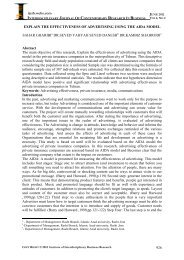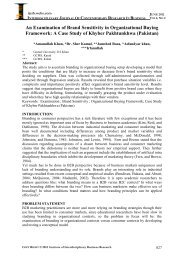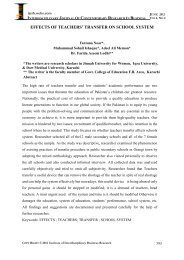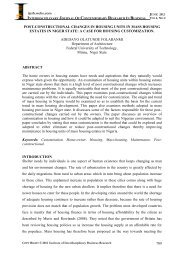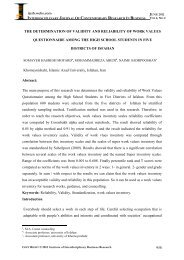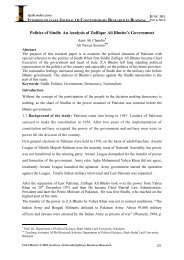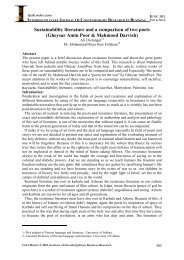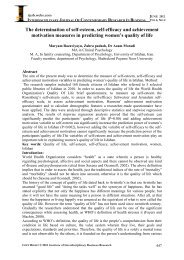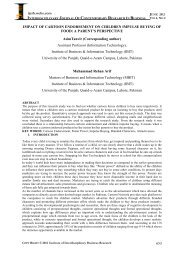The Role of the Psychological Capital on Quality of Work Life And ...
The Role of the Psychological Capital on Quality of Work Life And ...
The Role of the Psychological Capital on Quality of Work Life And ...
Create successful ePaper yourself
Turn your PDF publications into a flip-book with our unique Google optimized e-Paper software.
ijcrb.webs.com<br />
INTERDISCIPLINARY JOURNAL OF CONTEMPORARY RESEARCH IN BUSINESS<br />
COPY RIGHT © 2012 Institute <str<strong>on</strong>g>of</str<strong>on</strong>g> Interdisciplinary Business Research<br />
JUNE 2012<br />
VOL 4, NO 2<br />
researchers have attempted to measure QWL in a variety <str<strong>on</strong>g>of</str<strong>on</strong>g> settings using combinati<strong>on</strong>s <str<strong>on</strong>g>of</str<strong>on</strong>g><br />
various questi<strong>on</strong>naires such as job satisfacti<strong>on</strong>, organizati<strong>on</strong>al commitment, alienati<strong>on</strong>, job<br />
stress, organizati<strong>on</strong>al identificati<strong>on</strong>, job involvement and finally work role ambiguity,<br />
c<strong>on</strong>flict, and overload were studied as proxy measures <str<strong>on</strong>g>of</str<strong>on</strong>g> QWL.<br />
<str<strong>on</strong>g>The</str<strong>on</strong>g>re appeared to be no <strong>on</strong>e comm<strong>on</strong>ly accepted definiti<strong>on</strong> for quality <str<strong>on</strong>g>of</str<strong>on</strong>g> work life. Heskett,<br />
Sasser and Schlesinger (1997) proposed that QWL, which was measured by <str<strong>on</strong>g>the</str<strong>on</strong>g> feelings that<br />
employees have towards <str<strong>on</strong>g>the</str<strong>on</strong>g>ir jobs, colleagues, and companies would enhance a chain effect<br />
leading to organizati<strong>on</strong>’s growth and pr<str<strong>on</strong>g>of</str<strong>on</strong>g>itability. According to Havlovic (1991), and Straw<br />
and Heckscher (1984), <str<strong>on</strong>g>the</str<strong>on</strong>g> key c<strong>on</strong>cepts captured in QWL include job security, better reward<br />
systems, higher pay, opportunity for growth, and participative groups am<strong>on</strong>g o<str<strong>on</strong>g>the</str<strong>on</strong>g>rs. Walt<strong>on</strong><br />
(1974) proposed <str<strong>on</strong>g>the</str<strong>on</strong>g> c<strong>on</strong>ceptual categories <str<strong>on</strong>g>of</str<strong>on</strong>g> QWL. He suggested eight aspects in which<br />
employees percepti<strong>on</strong>s towards <str<strong>on</strong>g>the</str<strong>on</strong>g>ir work organizati<strong>on</strong>s could determine <str<strong>on</strong>g>the</str<strong>on</strong>g>ir QWL:<br />
adequate and fair compensati<strong>on</strong>; safe and health envir<strong>on</strong>ment; development <str<strong>on</strong>g>of</str<strong>on</strong>g> human<br />
capacities; growth and security; social integrative c<strong>on</strong>stituti<strong>on</strong>alism; <str<strong>on</strong>g>the</str<strong>on</strong>g> total life space and<br />
social relevance.<br />
In UK, Gilgeous (1998) assessed how manufacturing managers perceived <str<strong>on</strong>g>the</str<strong>on</strong>g>ir QWL in five<br />
different industries. Despite <str<strong>on</strong>g>the</str<strong>on</strong>g> growing complexity <str<strong>on</strong>g>of</str<strong>on</strong>g> working life, Walt<strong>on</strong>’s (1974) eightpart<br />
typology <str<strong>on</strong>g>of</str<strong>on</strong>g> <str<strong>on</strong>g>the</str<strong>on</strong>g> dimensi<strong>on</strong>s <str<strong>on</strong>g>of</str<strong>on</strong>g> QWL remains a useful analytical tool.Using samples from<br />
Standard & Poors 500 companies, Lau (2000) found that QWL companies have a higher<br />
growth rate as measured by <str<strong>on</strong>g>the</str<strong>on</strong>g> five-year trends <str<strong>on</strong>g>of</str<strong>on</strong>g> sales growth and asset growth. However,<br />
<str<strong>on</strong>g>the</str<strong>on</strong>g> outcome for pr<str<strong>on</strong>g>of</str<strong>on</strong>g>itability yield mixed results <strong>on</strong> Walt<strong>on</strong>’s (1974) c<strong>on</strong>ceptualisati<strong>on</strong> <str<strong>on</strong>g>of</str<strong>on</strong>g><br />
QWL. Saklani (2004) stressed that with <str<strong>on</strong>g>the</str<strong>on</strong>g> ever-changing technology and increased access to<br />
informati<strong>on</strong>, <str<strong>on</strong>g>the</str<strong>on</strong>g> study <str<strong>on</strong>g>of</str<strong>on</strong>g> organizati<strong>on</strong>s with respect to productivity, efficiency and quality <str<strong>on</strong>g>of</str<strong>on</strong>g><br />
services very crucial in order to improve <str<strong>on</strong>g>the</str<strong>on</strong>g> performance <str<strong>on</strong>g>of</str<strong>on</strong>g> work in India. <str<strong>on</strong>g>The</str<strong>on</strong>g> need to<br />
improve organizati<strong>on</strong>al productivity in <str<strong>on</strong>g>the</str<strong>on</strong>g> health care industry has spurred Brooks and<br />
<strong>And</strong>ers<strong>on</strong> (2005) to develop <str<strong>on</strong>g>the</str<strong>on</strong>g> c<strong>on</strong>struct <str<strong>on</strong>g>of</str<strong>on</strong>g> quality <str<strong>on</strong>g>of</str<strong>on</strong>g> nursing work life. <str<strong>on</strong>g>The</str<strong>on</strong>g>y came out with<br />
four dimensi<strong>on</strong>s <str<strong>on</strong>g>of</str<strong>on</strong>g> <str<strong>on</strong>g>the</str<strong>on</strong>g> c<strong>on</strong>ceptual framework namely; work life/home life dimensi<strong>on</strong>, work<br />
design dimensi<strong>on</strong>, work c<strong>on</strong>text dimensi<strong>on</strong> and work world dimensi<strong>on</strong>. In ano<str<strong>on</strong>g>the</str<strong>on</strong>g>r study d<strong>on</strong>e<br />
by Wyatt and Chay (2001), <str<strong>on</strong>g>the</str<strong>on</strong>g>y found four dimensi<strong>on</strong>s <str<strong>on</strong>g>of</str<strong>on</strong>g> QWLam<strong>on</strong>g <str<strong>on</strong>g>the</str<strong>on</strong>g> predominantly<br />
Chinese Singapore sample <str<strong>on</strong>g>of</str<strong>on</strong>g> employees. In Malaysia, Hanefah & et al. (2003), designed,<br />
developed and tested QWL measure for pr<str<strong>on</strong>g>of</str<strong>on</strong>g>essi<strong>on</strong>als, namely public and government<br />
accountants and architects. <str<strong>on</strong>g>The</str<strong>on</strong>g>y c<strong>on</strong>ceptualized QWL as a multi-dimensi<strong>on</strong>al c<strong>on</strong>struct<br />
comprised <str<strong>on</strong>g>of</str<strong>on</strong>g> seven dimensi<strong>on</strong>s, namely growth and development, participati<strong>on</strong>, physical<br />
envir<strong>on</strong>ment, supervisi<strong>on</strong>, pay and benefits, social relevance and workplace integrati<strong>on</strong>. In<br />
summary, several studies that have examined QWL dimensi<strong>on</strong>s varied significantly not <strong>on</strong>ly<br />
across countries but also am<strong>on</strong>g researchers. This study was an attempt to fur<str<strong>on</strong>g>the</str<strong>on</strong>g>r develop <str<strong>on</strong>g>the</str<strong>on</strong>g><br />
dimensi<strong>on</strong>s <str<strong>on</strong>g>of</str<strong>on</strong>g> QWL in iran.<br />
<str<strong>on</strong>g>The</str<strong>on</strong>g>refore, according to what was discussed above, <str<strong>on</strong>g>the</str<strong>on</strong>g> first hypo<str<strong>on</strong>g>the</str<strong>on</strong>g>sis was proposed as<br />
following:<br />
H1: QWL has a positive impact <strong>on</strong> performance.<br />
2. <str<strong>on</strong>g>Psychological</str<strong>on</strong>g> <str<strong>on</strong>g>Capital</str<strong>on</strong>g> (PsyCap)<br />
C<strong>on</strong>cern about trait-like pers<strong>on</strong>ality and state-like psychological capacities <str<strong>on</strong>g>of</str<strong>on</strong>g> employees has<br />
received little attenti<strong>on</strong> by organizati<strong>on</strong>al behavior researchers. Trait-like pers<strong>on</strong>ality is not<br />
specific to any task or situati<strong>on</strong> and tends to be stable over time, whereas state-like<br />
psychological capacities are more specific to certain situati<strong>on</strong>s or tasks and tend to be more<br />
malleable over time (Chen & et al, 2000). Several related c<strong>on</strong>cepts that describe state-like<br />
psychological capacities <str<strong>on</strong>g>of</str<strong>on</strong>g> employees can be found in <str<strong>on</strong>g>the</str<strong>on</strong>g> literature <strong>on</strong> positive<br />
208



